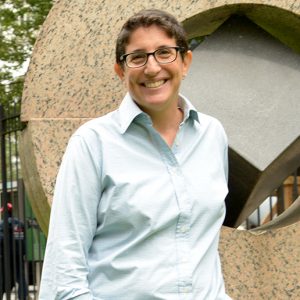The consortium is inviting faculty to become affiliated members.
“What we really want to do is incorporate a lot of the work that our faculty and staff are doing all over the world, and channel them through the consortium,” said O. Hugo Benavides, Ph.D., consortium director and chair of the sociology and anthropology department.
Collaborating to Avoid ‘Double Efforts’
Benavides formed the consortium last fall along with two co-directors: Aseel Sawalha, Ph.D., associate professor of anthropology, and Matthew Chin, Ph.D., assistant professor in the Graduate School of Social Service. GSC’s goal is to promote and integrate existing global research initiatives across the University’s different schools, departments, and programs—especially projects that are very similar.
“That’s one of the things we’re really interested in, so that people don’t do double efforts and reinvent the wheel,” said Benavides. “[With the consortium] they can reach out very easily to other colleagues that are doing similar work.”
To better understand the needs of his colleagues, Benavides and his colleagues hosted a forum this past November at the Lincoln Center campus. About 20 faculty members from at least four different schools sat at a table and shared their research objectives. A similar forum will be held next spring. Over the next couple of months, GSC will also create a consortium listserv and website.
“Our hope is to get people talking to each other so that they could do more collaborative research projects and apply for external grants,” Benavides said.
Research Abroad
The group is also planning for some travel. It will be co-sponsoring the third Fordham University Faculty Research Abroad Program (FRAP), designed to facilitate research collaboration between Fordham and foreign scholars, next summer in Rio de Janeiro, Brazil.
“Members who are affiliated to us have access to form different collaborations with other universities and colleagues at other universities,” Benavides said.
At the heart of the consortium is research that has an impact on local communities, said Benavides.
“We want to get involved with activists and artists and local communities and the kind of issues that are important and relevant to us today,” Benavides explained. “And particularly to use the strengths that our faculty have.”
Anyone interested in becoming a GSC affiliated faculty member should contact Benavides, Sawalha, or Chin at [email protected], [email protected], or [email protected].
]]>
“It seems obvious, but when you control for the safety, the students actually performed better,” said Laura Wernick, Ph.D., the study’s principal investigator and an assistant professor in the Graduate School of Social Service (GSS). “And ‘safe’ is the keyword here, because no matter where you are in the political spectrum you wouldn’t want kids beating each other up.”
The study, “Gender Identity Disparities in Bathroom Safety and Wellbeing Among High School Students,” employed a “climate survey” conducted in 2014 of five public high schools in southeast Michigan to examine the relationship between students’ gender identity, how safe they felt using bathroom facilities, and their schoolwork. The article was co-authored with her research assistant Alex Kulick, Ph.D., and Matthew Chin, Ph.D, assistant professor of social work at GSS.
“The experience that trans youth have with bathrooms has an impact on their grades and their self esteem,” she said. “This is such an important bodily function, that it’s going to have an effect when you place a student in a situation where they have to hold it in because they’re afraid.”
Very few empirical studies have focused on this issue within the context of high schools, said Wernick.
The study’s questionnaire was generated by the students themselves in a process known as community-based participatory action research. The teens had participated in a study before, but Wernick said they felt the questions hadn’t addressed all their concerns. Working with Wernick, the teens created an organizing model that would ultimately cross multiple identities—race, class, gender, and religion, to name a few.
“It’s an interesting model because we have young people from the schools, and they can word the questions to that particular school,” she said. “It speaks to the power of youth taking leadership.”
Through a coalition of several queer/straight alliance clubs in and around Detroit, the investigators were able to survey two rural, two suburban, and one urban high school.
In determining each school’s climate, the study gauged the extent to which the young people experienced microaggressions or outright slurs, physical harassment, or both. An earlier version of the study was conducted in 2007, but this 2014 survey was revised to incorporate more more questions on gender identity, bathrooms, and self-esteem issues.
In the three years that have passed from the initial survey to its publication this month, the nation has seen a sea change in politics, not all of it favorable to transgender students, noted Wernick.
“What I’m hearing from the young people is that the current climate is raising a lot more concerns, there’s a bit of a backlash,” said Wernick. However, some schools are moving forward to protect the teens, she said.
Wernick said it was a “negotiated process” getting the study, which was conducted during class time, in through the school administrations. “Some schools were excited, some were a little wary, and some clearly didn’t want to go with it.”
Although the survey was limited to 1,000 students in southeast Michigan, Wernick said the rural-suburban-urban context makes it a microcosm.
“It’s an interesting snapshot of the United States.”
]]>